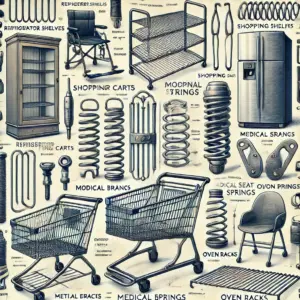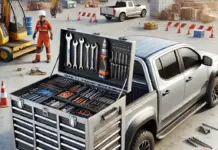
If you look around, chances are you’ll see something made from bent or shaped metal wire. It could be the shelves in your fridge, the springs in your mattress, or even the basket of a shopping cart. But have you ever thought about how those things are made?
Custom wire forming is the process of shaping metal wire into useful products. It sounds simple, but getting the right shape, strength, and durability takes skill and precision. Factories use special machines to bend, cut, and shape wire into everything from medical tools to car parts. Without this process, a lot of everyday objects wouldn’t exist—or at least, they wouldn’t work as well as they do.
What Exactly Is Custom Wire Forming?
Custom wire forming is when manufacturers take metal wire and shape it into specific forms for different uses. The word “custom” means that the wire isn’t just bent randomly—it’s carefully designed for a specific function.
For example, the wire racks inside an oven need to handle high heat without warping. The springs inside a couch need to be flexible but strong enough to hold weight. Even something as simple as a paperclip has to be formed in a way that lets it bend without snapping.
The process involves different techniques depending on the material and the final product. Some wires are bent into 3D shapes, while others are coiled into springs or cut into precise lengths. The goal is to make sure the final product is strong, reliable, and fits its purpose perfectly.
One of the best ways to get high-quality custom wire products is by working with an experienced custom wire forming company. These manufacturers have the right tools and expertise to create wire products that meet exact needs, whether for industrial machines or household items.
Where Do We See Custom Wire Products?
Most people don’t realize just how much custom wire forming affects their daily lives. It’s everywhere, even in places you wouldn’t expect. Here are some of the most common uses:
- Home and Kitchen Products
Wire shelves in refrigerators, dish racks, oven grates, and even toaster racks are all made through custom wire forming. These products need to be strong and resistant to rust, especially in humid or hot environments.
- Automotive and Transportation
Cars, bikes, and airplanes all use wire components. Springs in car seats, throttle cables, and even some engine parts are formed from wire. These parts need to be precise and durable to handle constant movement and pressure.
- Medical Equipment
Surgical tools, braces, and even hospital bed frames rely on custom wire forming. Medical wires need to be incredibly precise because they’re often used in life-saving equipment. Some are even made from special metals that resist bacteria and corrosion.
- Retail and Storage Solutions
Shopping carts, store display racks, and wire baskets are all products of custom wire forming. They need to be sturdy enough to hold weight but also lightweight for easy movement.
- Furniture and Mattresses
The springs in your couch or mattress? Those are wire-formed products. They need just the right amount of flexibility to provide comfort without wearing out too quickly.
How Is Custom Wire Forming Done?
There are different ways to shape metal wire, depending on what it’s being used for. Here are some of the most common techniques:
- CNC Wire Bending
CNC (Computer Numerical Control) machines use computer programming to bend wire into precise shapes. This method is extremely accurate, making it perfect for industries like aerospace and medical manufacturing.
- Spring Coiling
Springs are made by tightly winding wire into coils. The size, shape, and tension of the coils determine how the spring will function. Some springs need to be soft and flexible, while others need to be stiff and strong.
- Wire Welding and Assembly
Some wire products require multiple pieces to be joined together, like shopping carts or storage racks. This is done through welding, which fuses the wire pieces into one strong structure.
- Cutting and Stamping
Some wires need to be cut into specific lengths or have patterns stamped into them. This process is common in electrical wiring and other applications where precision is key.
Why Quality Matters in Wire Forming
Not all wire-formed products are created equal. Cheaply made wire products can bend, break, or rust too easily. That’s why manufacturers pay close attention to the type of metal used, the shaping process, and even protective coatings.
For example, stainless steel is commonly used in kitchen products because it doesn’t rust. High-carbon steel is used in springs because it’s strong and flexible. Some wire products are coated with plastic or other materials to prevent corrosion or improve grip.
When wire forming is done right, the final product lasts longer and performs better. That’s why industries like healthcare and automotive manufacturing rely on high-precision wire forming to meet strict safety and quality standards.
The Future of Wire Forming
As technology improves, so does wire forming. Advanced CNC machines now allow for even more precise bends and shapes. Some companies are experimenting with 3D printing metal wire to create complex designs that weren’t possible before.
Sustainability is also becoming a big focus; many manufacturers are looking for ways to reduce waste and use recycled metals as this not only helps the environment but also makes production more cost-effective.
No matter how it evolves, one thing is clear—custom wire forming isn’t going anywhere. It’s a crucial part of making products that people rely on every day.
Final Thoughts
You might not think about wire forming much, but it’s everywhere. From the chair you sit on to the car you drive, countless products depend on carefully shaped metal wire. The next time you pick up a shopping basket or stretch out on your mattress, take a second to appreciate the work that went into shaping it.
Custom wire forming may not be the flashiest part of manufacturing, but without it, many of the things we use every day wouldn’t exist.







